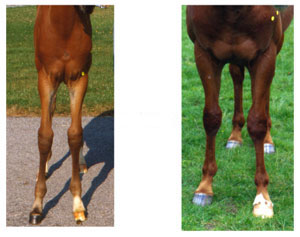Unfortunately, every horse is an individual and thus general rules are hard to formulate. But there are SOME rules that are worthwhile knowing. Below I summarize my very limited understanding of this topic, I will keep updating it as I learn and understand more.
1. Natural asymmetry
Most healthy hooves show a pattern of "natural asymmetry", which describes the fact that the medial (inside) hoof wall is usually steeper than the lateral (outside) hoof wall. Here is an theoretical example, taken from an article by James Rooney, D. V. M.:
As a consequence, the side of the hoof with the steeper wall is usually slightly smaller. This can be seen from this picture of a dead mustang on the road (origin of picture unknown). The yellow and the orange line have the same length.
Brian Hampson, in his study of several populations of Australian wild horses (Brumbies) inhabiting various different habitats, found that all populations apart from one (the desert rocky population, which is not a natural and ancestral habitat for the horse!) showed the same pattern of a steeper medial than lateral hoof wall (see page 44 of Peter Ramey: Care and Rehabilitation of the Equine foot). So this observation seems to be a real and general one, and as such demands an explanation.
According to James Rooney, this pattern is a direct consequence of the forces that act on the hooves by the "center of mass" of the horse, which is concentrated in the middle, i.e. between the two hooves. The ratio of the "outward" to "downward" vector of the forces exerted by the body mass of the horse is skewed towards outside on the lateral hoof walls, thus shaping the hoof in this way.
This model would predict that the medial wall would be falling behind the vertical, something that is not usually observed. I think this tendency is offset by the way the legs advance on a healthy, straight-legged horse. I will come back to this aspect in a new post, describing how a healthy horse loads its hoof during movement.
Newborn foals do not show such a medial-lateral wall angle asymmetry. It only develops once the hoof is subjected to the body weight of the horse.
My horses both show the phenomenon, though Gus much less pronounced than Molly. One explanation for that fact could be that Gus grew up on hard rocky ground (in Texas), similar to the desert rocky brumbies, and Molly on soft (wet) pastures in Michigan. The dry, rocky conditions in Texas have formed a hoof that has more similar steep walls medially and laterally and as the coffin bone grows it is shaped by the hoof capsule around it to take on that same pattern.
We have to assume that in order for the previous principles to apply the horse must have healthy normal straight (slightly valgus can be considered normal, see picture below) legs.
 |
| This slight valgus leg conformation can be considered normal |



Maybe this link will help you: http://elib.tiho-hannover.de/dissertations/corbini_ws04.pdf
ReplyDeletewow, great! Thanks a lot!
ReplyDeleteI don't understand what lines mean what on the above diagram.
ReplyDeletecm is the center of mass, i.e weight of the horse. Red lines indicate the vectors of forces that act on the lateral side of the front right hoof, the force comes simply from the center of the horses weight being BETWEEN the legs. Green is vectors of forces that act on the medial side of front right hoof. You can see that the red arrow that points towards the left (outside) is larger than the green that points towards the left. I.e. more shallow wall angle.
ReplyDelete